I. Recent Tilray Stock Performance
Tilray Brands (NASDAQ: TLRY) has experienced significant fluctuations in its stock price over the recent period. The stock has a 52 week range of $1.50-$3.40.
In the short term, Tilray's momentum appears to be on a downward trajectory. Over the past three months, the stock has recorded a negative price performance of -13.50%, indicating a notable decline in value. This trend continues over the six-month period, with a 9.42% decrease in price performance. The negative momentum persists even over the nine-month period, albeit to a lesser extent, with a 2.26% decline. These figures suggest that Tilray stock has faced challenges and struggles in generating positive returns for investors in the immediate past.
Zooming out to a one-year time frame provides a broader perspective on Tilray's performance, revealing a substantial decline in its stock price. With a one-year price performance of -28.22%, Tilray has experienced a significant drop in value over the past year.
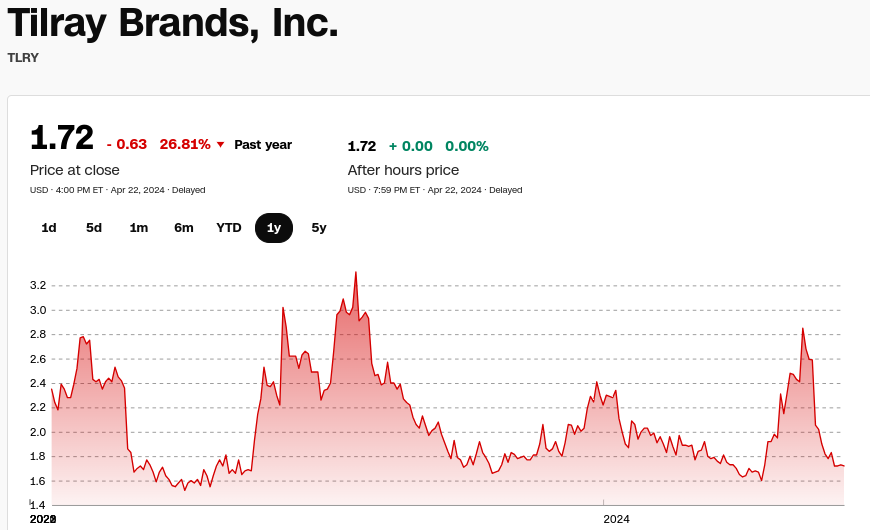
Source: cnn.com
Influencing factors
Tilray Brands operates in a dynamic landscape shaped by a multitude of factors.
Regulatory Environment: Regulatory shifts significantly impact Tilray's operations. For instance, in Canada, the excise tax structure directly affects profitability. Tilray anticipates annual savings of $80 million if the current per-gram tax is replaced with a 10% Ad Valorem Tax. Additionally, regulatory reforms, such as changes in THC potency regulations and marketing rules, can open new market opportunities.
Market Positioning: Tilray's market dominance in key regions like Canada and Germany provides a competitive edge. With the largest market share in Canada and leading revenue share in Germany, Tilray is strategically positioned to capitalize on market growth. Moreover, its diversified portfolio spanning both adult-use and medical cannabis strengthens its market resilience.
International Expansion: Tilray's global expansion strategy leverages emerging markets like Germany and Europe. The projected $3 billion German medical cannabis market and potential $45 billion European market offer significant growth prospects. Regulatory changes, such as the removal of medical cannabis from narcotics acts, present opportunities for Tilray to expand its product offerings and increase market penetration.
Acquisitions and Diversification: Tilray's acquisition strategy, exemplified by HEXO and Truss acquisitions, aims to drive synergies and expand market reach. Cost-saving initiatives, like SKU rationalization and facility consolidation, enhance operational efficiency. Diversification into adjacent markets, such as beverages and wellness products, mitigates risks and fosters revenue growth.
Innovation and Branding: Tilray's focus on innovation and branding underpins its market leadership. Investments in product innovation, like THC-infused beverages and hemp-based derivatives, cater to evolving consumer preferences. Strategic branding efforts, such as the revitalization of Shock Top and expansion into non-alcoholic crafts, aim to capture new consumer segments and occasions.
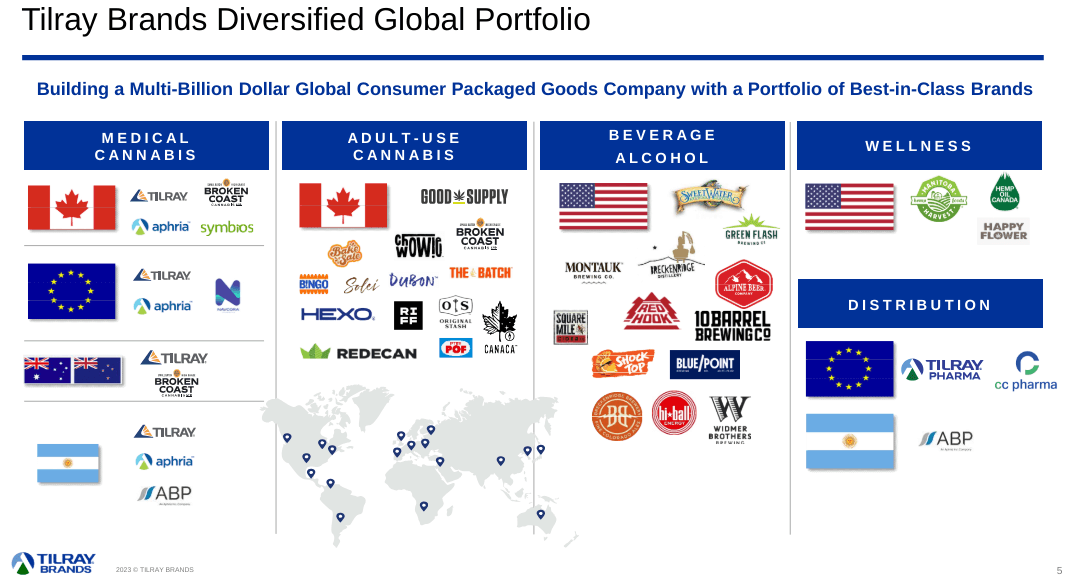
Source: Investor Presentation
Financial Performance: Tilray's financial performance reflects its growth trajectory and operational efficiency. Despite challenges like excise tax increases and price compression, Tilray achieved significant revenue growth of 30% in Q3. Positive adjusted free cash flow and debt reduction initiatives enhance financial stability and flexibility, reinforcing investor confidence.
Expert Insights on Tilray Brands Stock Forecast for 2024, 2025, 2030 and Beyond
Tilray Brands stock assigned a price target of $4.25 by 2024, reflecting cautious optimism amid regulatory uncertainties. By 2025, a moderate increase to $5.75 is anticipated as legalization efforts gain traction, though market saturation remains a concern. Looking to 2030, there will be a potential rise to $15.65 or beyond if global legalization accelerates.
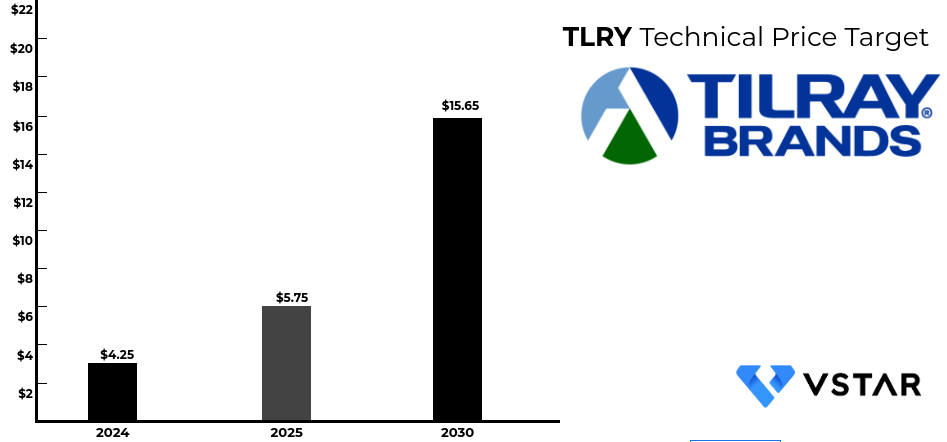
Source: Analyst's compilation
II. Tilray Stock Forecast 2024
TLRY price target by the end of 2024 is set at $4.25. This projection is based on the momentum of change-in-polarity over the short-term, and it's projected over Fibonacci retracement/extension levels. This indicates an expectation for a significant increase in the stock price over the coming years, driven by identified shifts in market sentiment and technical analysis of historical price movements.
The current price of Tilray Brands stands at $1.73, which is below the trendline and baseline of $2.01, based on a modified exponential moving average. This indicates a bearish trend as the current price is lower than the trendline, suggesting downward momentum. The direction of the stock price is described as sideways, implying a lack of clear upward or downward movement in the immediate term. However, considering the current price being below both the trendline and baseline, there's a suggestion of a bearish sentiment.
- Primary Support: $1.79
- Pivot of Current Horizontal Price Channel: $2.00
- Resistance Levels: $3.27 (in case of heightened volatility), $2.67 (core resistance), $2.21
- Core Support: $1.33
These levels provide crucial points for investors to monitor. The primary support and pivot of the current horizontal price channel indicate potential areas where buying interest could increase. Resistance levels signify points where selling pressure may intensify. Core support at $1.33 is particularly important as it represents a strong level of potential buying interest.
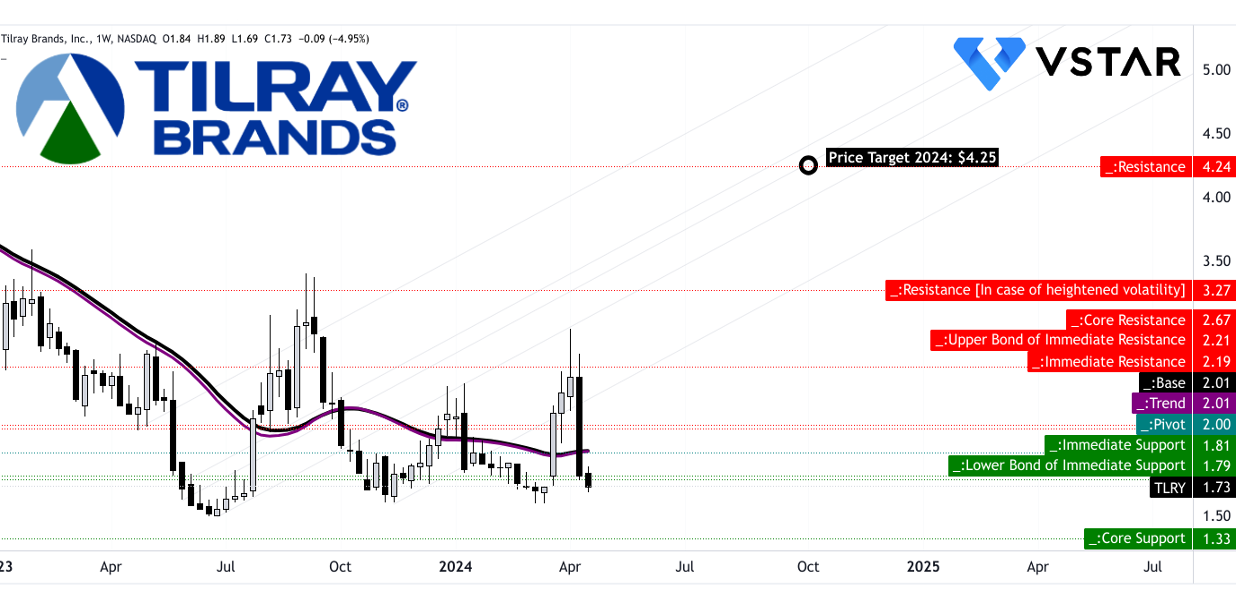
Source: tradingview.com
On the other hand, the Relative Strength Index (RSI) value is currently at 41.8, indicating a neutral stance. There are no clear signals of regular bullish or bearish levels, nor are there any indications of bullish or bearish divergences. However, the RSI line trend is down, suggesting a weakening of bullish momentum. This implies that while the RSI is not in extreme territory, the downward trend may indicate potential for further price declines.
The moving average convergence/divergence (MACD) line is currently at -0.442, below the signal line of -0.0531, indicating a bearish trend. Despite the trend being bullish, the strength of the trend is decreasing, as indicated by the decreasing histogram value of 0.0089. This suggests that while the overall trend is bullish, there's a weakening momentum behind it, potentially signaling a reversal in the near future.
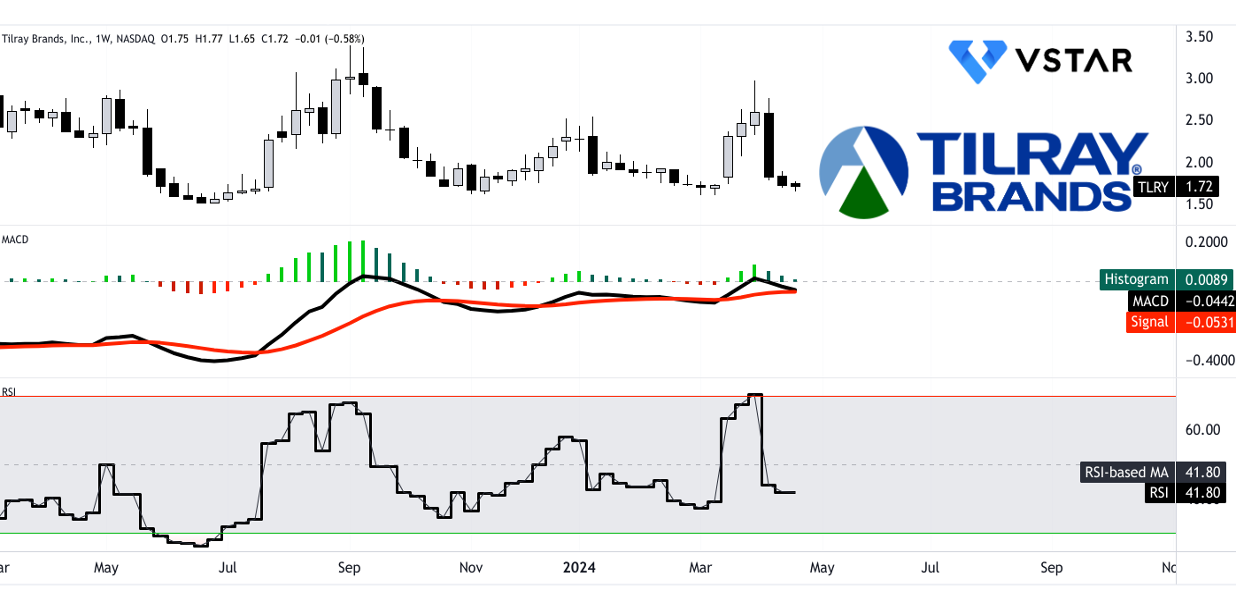
Source: tradingview.com
According to tipranks.com, a consensus among seven Wall Street analysts suggests an average Tilray price target of $2.62 in the next 12 months. This forecast indicates a substantial 51.45% increase from the current price of $1.73. While the high forecast of $4.10 portrays optimism, the low forecast of $2.00 underscores potential volatility.
Contrastingly, cnn.com's data unveils a more reserved outlook. Among 16 analyst ratings, only 19% advocate buying, while 81% advise holding Tilray stocks. The TLRY forecast ranges from a high of $4.00 to a low of $1.90, with a median projection of $2.10. Such a consensus leans heavily towards cautious optimism, acknowledging the stock's potential while urging restraint.
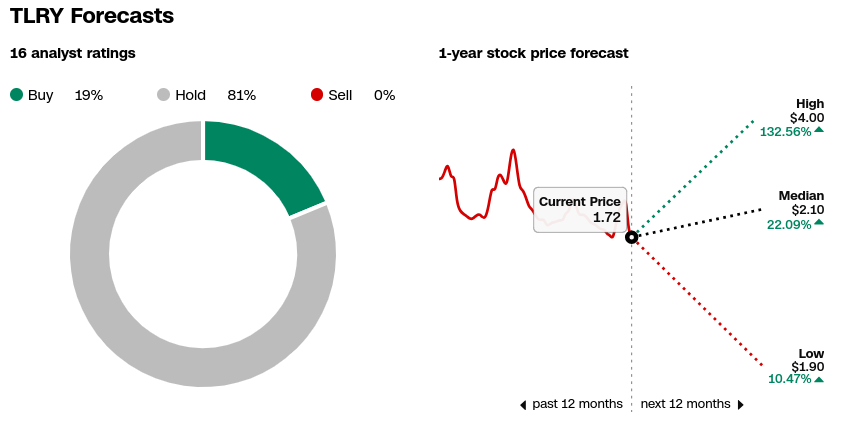
Source: cnn.com
Coinpriceforecast.com provides a long-term perspective, estimating Tilray stock price to reach $2 by the end of 2024, with an interim forecast of $1.83 by mid-year. This projection indicates a moderate 19% increase over the course of the year.
A. Other TLRY Stock Forecast 2024 Insights: Is Tilray a good stock to buy?
Tilray Brands has been subject to varying outlooks from financial institutions and analysts, as evidenced by recent forecasts and ratings adjustments. On April 10, 2024, Canaccord Genuity Group lowered its TLRY stock price target from $4.25 to $4.00 while maintaining a "Buy" rating. Similarly, CIBC adjusted its target from $2.25 to $2.00 while keeping its rating at "Neutral."
These adjustments likely reflect shifts in market sentiment or changes in the company's fundamental outlook. For Canaccord Genuity, the reduction in price target could suggest concerns about Tilray's growth prospects or operational performance, prompting a more conservative valuation. Conversely, CIBC's decision to maintain a "Neutral" rating alongside a lowered target may indicate a more cautious stance on the stock's potential, possibly due to broader industry trends or specific company developments.
Contrastingly, Alliance Global Partners increased its target for Tilray from $2.25 to $2.75 on April 5, 2024, while maintaining a "Neutral" rating. This optimistic adjustment could stem from positive developments within Tilray's business, such as promising financial results or strategic initiatives that are perceived to enhance its long-term prospects.

Source: marketbeat.com
B. Key Factors to Watch for TLRY Stock Prediction 2024
In analyzing Tilray stock prediction for 2024, several key factors emerge from both recent financials and developments:
TLRY Stock Forecast 2024 - Bullish Factors
- Market Leadership: Tilray holds significant market share in Canada, Germany, and other international markets, positioning it well to capitalize on growth opportunities.
- Revenue Growth: Consensus revenue estimates indicate growth in upcoming quarters, with a focus on organic growth and strategic acquisitions.
- Global Cannabis Legalization: Tilray stands to benefit from potential cannabis legalization in the U.S., leveraging its global expertise and distribution network for immediate market penetration.
- Diversification: Tilray's expansion beyond cannabis into adjacent markets like beverage alcohol and wellness products diversifies its revenue streams, reducing dependency on any single segment.
- Cost Reduction Initiatives: Efforts to streamline operations and optimize cost structures, particularly through the HEXO integration plan, have shown progress, potentially improving profitability.
- Regulatory Reforms: Anticipated regulatory changes, such as adjustments to excise tax structures in Canada, could significantly impact Tilray's bottom line positively.
Tilray Stock Forecast 2024 - Bearish Factors
- Excise Tax Impact: High excise taxes in Canada continue to weigh on Tilray's gross margins, affecting its overall profitability.
- Competition and Price Compression: In the Canadian market, competition from the adult-use sector and price compression in the medical cannabis segment pose challenges to revenue growth.
- Regulatory Uncertainty: Despite potential for favorable regulatory changes, uncertainty remains regarding the timing and extent of cannabis legalization in key markets like the U.S., which could delay Tilray's expansion plans.
- Wholesale Cannabis Revenue: While wholesale agreements may help optimize inventory levels, they negatively impact gross profit and EBITDA, highlighting potential volatility in revenue streams.
- Dependency on Regulatory Reforms: Tilray's bullish outlook relies heavily on anticipated regulatory reforms, such as excise tax reduction and broader medical cannabis use in Germany. Delays or setbacks in these reforms could hinder growth prospects.
- Integration Challenges: While progress has been made in integrating acquisitions like HEXO, challenges in realizing synergies and optimizing cost structures may persist, impacting profitability in the short term.
III. Tilray Stock Forecast 2025
The price target for TLRY by the end of 2025 is projected at $5.75. This projection is based on the momentum of change-in-polarity over the mid- to short-term, combined with Fibonacci retracement/extension levels. It implies a significant potential upside from the current price of $1.73. However, achieving this target would require a substantial shift in market sentiment and significant positive catalysts for the stock.
Moreover, the current price of Tilray Brands stands at $1.73, below the trendline and baseline both set at $2.01, derived from a modified exponential moving average. This suggests a downward deviation from the expected trend. The modified exponential moving average indicates a potentially strong resistance level at $2.01, reflecting a challenge for TLRY to surpass.
The direction of the stock price is described as "Sideways," indicating a lack of clear upward or downward momentum. However, the current price being below both the trendline and baseline suggests a bearish sentiment in the short term.
The primary support at $1.79 indicates a critical level where buying pressure could potentially increase, supporting the stock price from further decline. However, the absence of specific support levels during heightened volatility suggests increased uncertainty and potential for sharper price movements.
The pivot of the current horizontal price channel at $2.00 serves as a crucial inflection point where the direction of TLRY's price movement could change. Breaking above this level might signal a bullish trend continuation, while dropping below could indicate further downside pressure.
Core resistance levels at $3.27, $2.67, and $2.21 represent significant barriers that TLRY needs to overcome to resume an upward trajectory. These levels are likely to attract selling interest, potentially limiting upside momentum unless convincingly breached.
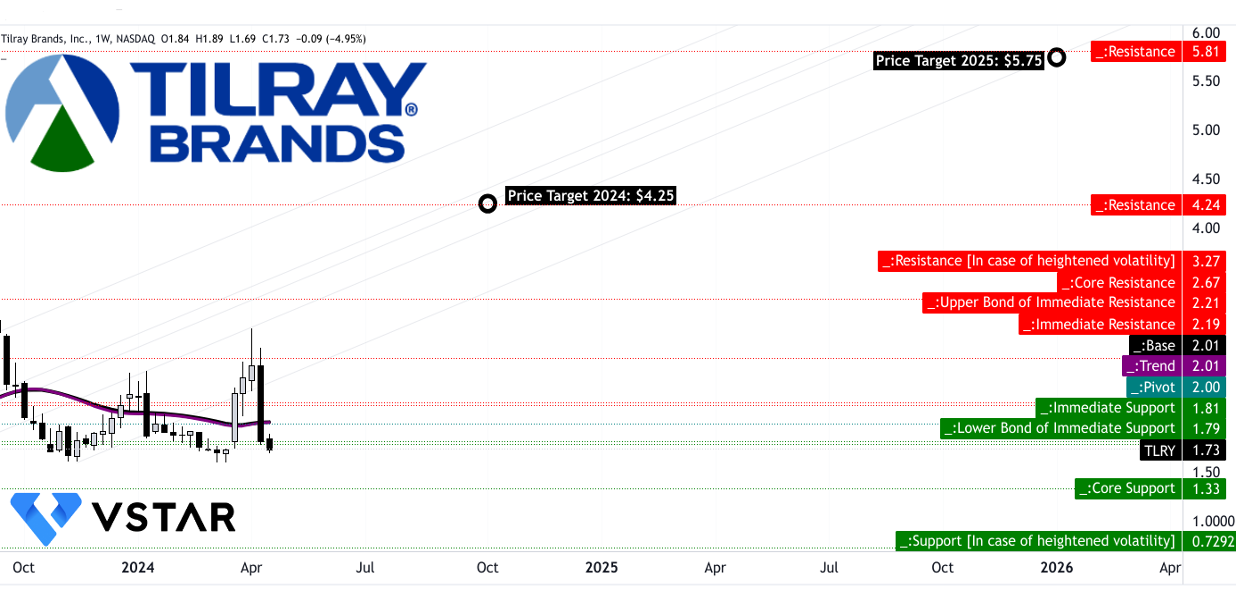
Source: tradingview.com
Looking at the Supertrend indicator, the stock price is now in mid-term uptrend mode. This support may push the price on a bullish trajectory for the mid-term (for 2025).
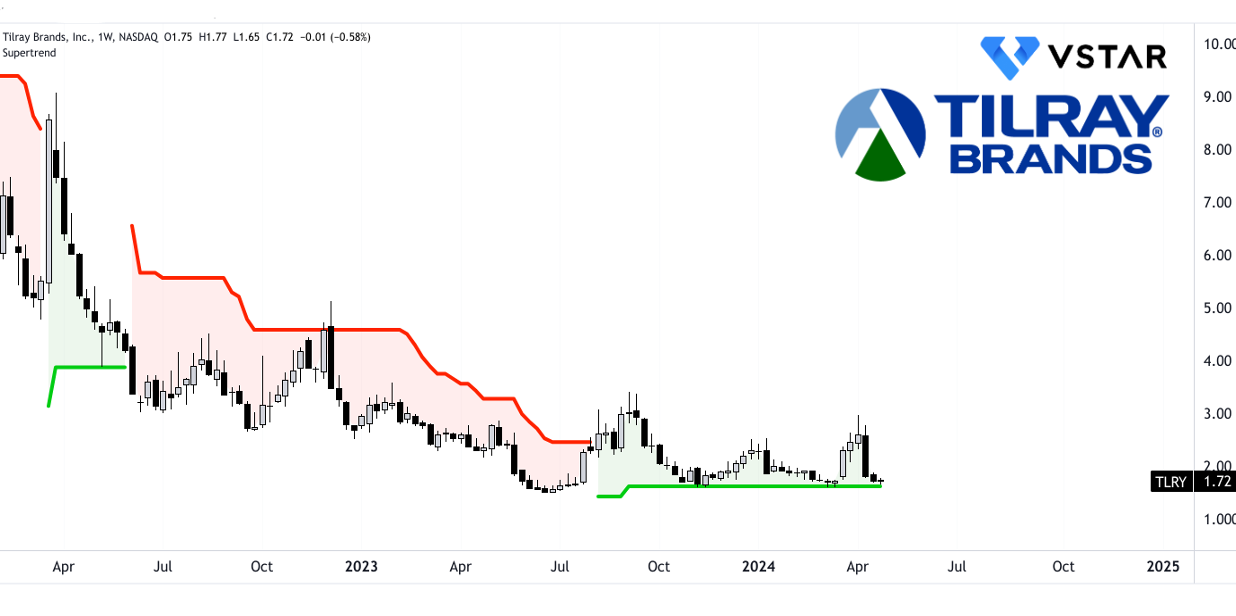
Source: tradingview.com
The forecasted performance of Tilray stock for 2025 presents a disparity between predictions from different sources. Coincodex.com anticipates a somewhat pessimistic outlook, forecasting a price of approximately $1.72, suggesting a marginal decrease of -0.39% compared to its current level. On the contrary, coinpriceforecast.com offers a more optimistic perspective, projecting a price of $3 by the end of 2025, indicating a significant 87% increase from the predicted mid-year price of $2.68.
A. Other TLRY Stock Forecast 2025 Insights: Tilray stock buy or sell?
As per Wall Street Journal, there are three "Buy" ratings, indicating a positive sentiment among some analysts towards Tilray stock price prediction 2025. However, there has been a decrease in the number of "Overweight" ratings, dropping from 2 to 0 over the past month. On the other hand, "Hold" ratings have remained relatively stable, indicating a cautious stance from a majority of analysts.
Examining price targets provides additional insight into analyst expectations. The high-end target for TLRY stock prediction 2025 stands at $4.00, which suggests an optimistic outlook for TLRY's future performance. However, the median target is $2.10, reflecting a more moderate expectation. The low-end target of $1.90 underscores the possibility of downside risk, while the average target of $2.37 serves as a midpoint among analysts' projections.
Comparing these targets to the current price of $1.72, there exists a variance in expectations. The high-end target implies potential significant upside, while the low-end target suggests limited appreciation. The median and average targets fall between these extremes, indicating a range of potential outcomes.
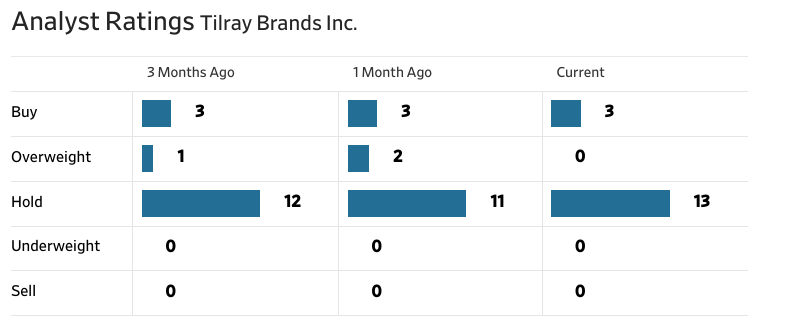
Source:WSJ.com
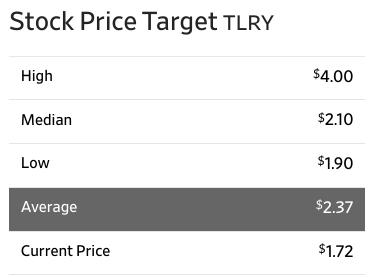
Source:WSJ.com
B. Key Factors to Watch for Tilray Stock Forecast 2025
TLRY Stock Forecast 2025 - Bullish Factors
- Market Leadership and Expansion: Tilray's dominant position in Canada's adult-use cannabis market and its leading market share in Germany provide a solid foundation for growth. With a focus on innovation and strategic acquisitions, Tilray aims to expand its market presence globally.
- Regulatory Reforms: Anticipated regulatory changes, such as the potential replacement of the excise tax regime in Canada with a 10% Ad Valorem Tax, could lead to significant cost savings for Tilray, estimated at $80 million annually. Moreover, regulatory reforms around marketing and THC potencies could further benefit the company.
- International Opportunities: Tilray's presence in multiple international markets, particularly in Europe, positions it to capitalize on the growing medical cannabis market. Legislative changes, such as the removal of medical cannabis from the Narcotics act in Germany, could significantly expand Tilray's market opportunities.
- Diversified Portfolio: Tilray's diversified portfolio of brands, including cannabis, beverage alcohol, and wellness products, allows it to tap into various consumer segments and market trends. Strategic acquisitions and product innovation contribute to revenue growth across different business segments.
Tilray Stock Forecast 2025 - Bearish Factors
- Regulatory Uncertainty: While regulatory reforms present opportunities, regulatory uncertainty, especially in the U.S., remains a risk factor. Tilray's inability to engage in U.S. cannabis operations due to federal regulations limits its growth potential in the world's largest cannabis market.
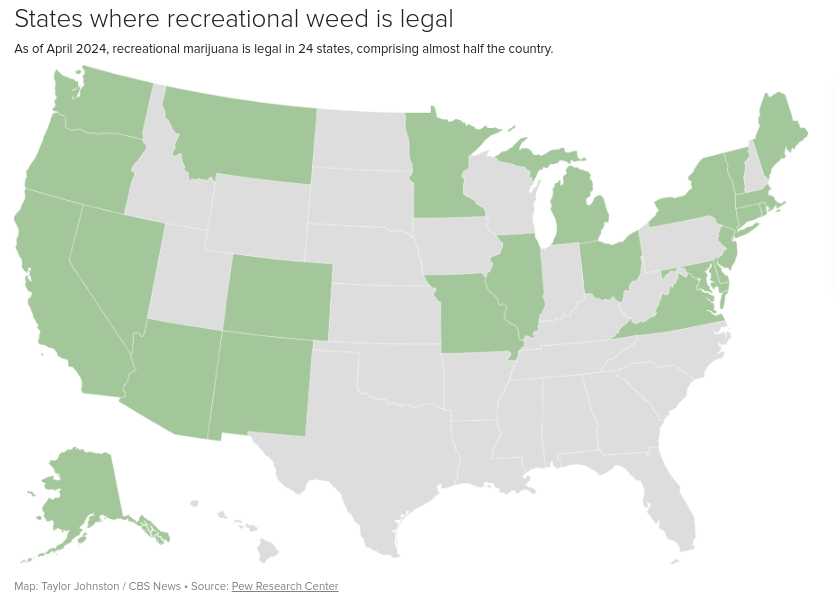
Source: CBSnews.com
- Excise Taxes and Pricing Pressures: The current excise tax structure in Canada, coupled with pricing pressures from competition, has led to increased excise taxes and compressed margins. Tilray's profitability could be negatively impacted if regulatory changes to address these issues are not implemented as expected.
- Integration Challenges: Integrating recent acquisitions, such as HEXO and Truss, poses challenges, including streamlining operations, optimizing costs, and achieving synergies. Delays or difficulties in the integration process could hinder Tilray's ability to realize expected cost savings and margin improvements.
- Market Volatility and Competition: The cannabis industry is characterized by market volatility and intense competition. Tilray faces competition from both established players and new entrants, which could pressure its market share and profitability if not effectively addressed.
IV. Tilray Stock Forecast 2030 and Beyond
The price target for Tilray Brands by the end of 2030 is set at $15.65. This ambitious target is based on momentum analysis, specifically considering changes in polarity over the long-term, projected over Fibonacci retracement/extension levels. Such a projection assumes significant bullish sentiment and sustained momentum over the long term.
The current price of Tilray Brands stands at $1.73, significantly below the trendline and baseline values of $3.23 and $3.54, respectively, indicating a downtrend. The modified exponential moving average (EMA) suggests a negative trajectory for the stock. However, it's noteworthy that the direction of the stock price is assessed as sideways, despite the clear indication of a downtrend. This could imply potential stabilization or consolidation in the near term.
Primary support is identified at $1.76, suggesting a critical level where buying pressure could potentially increase. The pivot of the current horizontal price channel is slightly higher at $2.26, indicating a possible area where price action might pivot. Resistance levels, especially core resistance at $3.83 and higher resistance at $11.15, present significant barriers for price advancement. Core support is at $0.70, indicating a historically strong level where buying interest has been substantial.
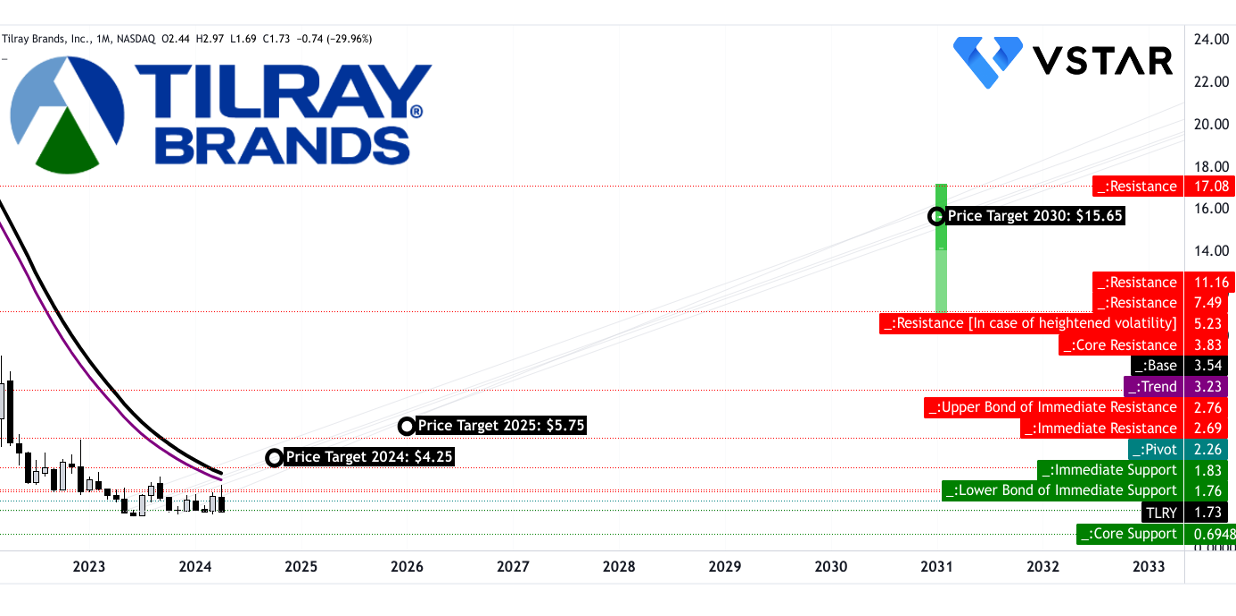
Source: tradingview.com
Moreover, the RSI value of 39.92 suggests the stock is neither oversold nor overbought, residing in a neutral zone. While there are no indications of regular bullish or bearish levels, the absence of bullish or bearish divergences implies a lack of significant buying or selling pressure beyond what's already reflected in the price. The upward trend of the RSI line suggests potential strengthening in buying momentum.
Finally, the MACD line at -2.39 is below the signal line at -3.58, indicating a bearish sentiment in the short term. However, the positive histogram value of 1.19 suggests a bullish trend that may be stabilizing. This suggests a mixed picture in terms of short-term price momentum, with bearish sentiment prevailing but with signs of potential stabilization or even reversal.
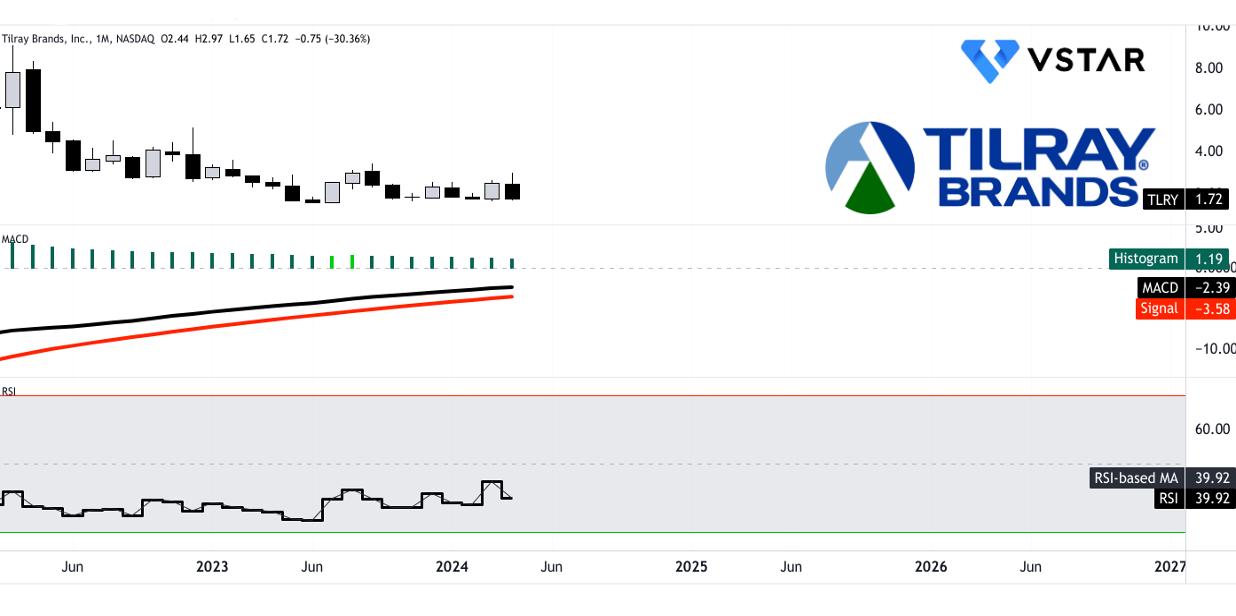
Source: tradingview.com
According to coincodex.com, Tilray stock is predicted to experience a gradual decline over the forecast period, with the stock price decreasing from $1.70 in 2025 to $1.67 by 2030. This projection suggests a pessimistic outlook, indicating potential challenges or stagnation in Tilray's business performance. Factors contributing to this downward trend could include increased competition, regulatory hurdles, or operational inefficiencies.
In contrast, coinpriceforecast.com offers a more optimistic view, forecasting significant growth in Tilray stock price over the same period. According to their predictions, Tilray stock is expected to appreciate steadily, reaching $5.65 by the end of 2030. This Tilray price prediction indicates confidence in Tilray's ability to capitalize on market opportunities, expand its market share, or innovate within the industry.
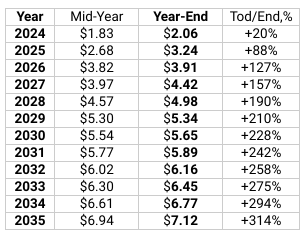
Source: coinpriceforecast.com
A. Other TLRY Stock Forecast 2030 and Beyond Insights: Is Tilray Brands a good stock to buy?
Tilray Brands is positioning itself within the rapidly expanding global cannabis market. As per Fortune Business Insights, the market is forecasted to reach $444 billion by 2030 (from $57.18 billion in 2023) at a CAGR of 34.03% (2023-2030). This growth is primarily attributed to the increasing legalization of marijuana worldwide, driven by its perceived medicinal benefits and cultural acceptance. The company's recent announcement of an expanded product lineup under its CANACA brand reflects its strategic efforts to capitalize on this market expansion.
The launch of the 'Let 'Er Rip' Campaign showcases Tilray Brands' focus on innovation and product quality. By introducing new offerings designed to elevate intensity and provide flavorful consumption experiences, the company aims to differentiate itself in a competitive landscape. This initiative aligns with the evolving preferences of cannabis consumers, who seek high-quality products that deliver unique and satisfying experiences.
Through its focus on innovation, Tilray Brands aims to surpass consumer expectations and strengthen its position in the market. The emphasis on product quality and brand narrative reflects the company's understanding of the importance of consumer perception and loyalty in driving long-term success. By continuously refining its processes and offerings, Tilray Brands strives to maintain a competitive edge and capture a significant share of the growing cannabis market.
B. Key Factors to Watch for Tilray Stock Price Prediction 2030 and Beyond
TLRY Price Prediction 2030 and Beyond - Bullish Factors
- Expanding Revenue Estimates: Tilray's revenue estimates show consistent growth, reaching $1.51 billion by May 2030. This growth is supported by the projected increase in the global cannabis market, which is expected to reach $444 billion by 2030. Tilray's strategic positioning within this market suggests potential for capturing a significant share of this growth.
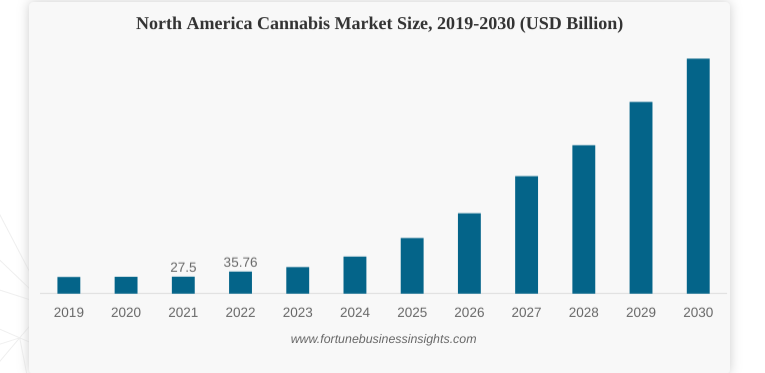
Source: fortunebusinessinsights.com
- Improving EPS: Consensus EPS estimates demonstrate a positive trend, with TLRY earnings per share expected to increase steadily, reaching $0.24 by May 2033. This indicates improving profitability over the forecast period, driven by potential operational efficiencies, market expansion, and product innovation.
- Positive Analyst Trends: Despite short-term fluctuations, there's a long-term positive trend in analyst estimates for both revenue and EPS. This suggests growing confidence in Tilray's ability to execute its strategic plans and capitalize on market opportunities over the next decade.
- Market Expansion Opportunities: As the global cannabis market expands, Tilray has the opportunity to leverage its brand recognition, distribution networks, and product portfolio to penetrate new markets and capture market share. Partnerships, acquisitions, and strategic alliances could further enhance Tilray's market presence and revenue streams.
TLRY Stock Price Prediction 2030 and Beyond - Bearish Factors
- Tilray Earnings Volatility: While revenue is projected to grow steadily, EPS estimates show volatility, especially in the short to medium term. Negative EPS estimates in the earlier years could signal potential challenges in managing costs, regulatory hurdles, or competitive pressures impacting profitability.
- Revenue Growth Rate Decline: Despite overall revenue growth, the growth rate is projected to decline from 9.24% in May 2030 to 4.24% in May 2033. This deceleration could be attributed to market saturation, increased competition, regulatory constraints, or shifts in consumer preferences, posing challenges to sustaining high growth levels.
- Market Competition: The cannabis industry is becoming increasingly competitive, with new entrants and established players vying for market share. Tilray faces the risk of pricing pressure, loss of market share, or margin erosion due to intensified competition, which could impact its long-term growth prospects.
- Regulatory Uncertainty: Regulatory changes or delays in cannabis legalization across key markets could hinder Tilray's expansion plans and disrupt its revenue growth trajectory. Adverse regulatory developments, such as stricter regulations or taxation policies, could negatively impact Tilray's financial performance and stock price outlook.
V. Tilray Stock Price History Performance
A. TLRY Stock Price Key Milestones
2014: Tilray's stock price was a mere $0.45 million, reflecting its early-stage position in the cannabis industry. The company was still establishing its presence and business model in the nascent legal cannabis market.
2015: Tilray experienced explosive growth, with its market cap soaring to $48.1 million, reflecting a staggering 10536.53% increase. This surge can be attributed to growing acceptance of medicinal cannabis and increasing investor interest in the emerging industry.
2016: Tilray continued its rapid expansion, with its market cap reaching $0.41 billion, marking a significant milestone in its growth trajectory. The company likely benefited from favorable regulatory developments and expanding market opportunities.
2017: Tilray's market cap surged to $2.24 billion, representing a remarkable 433.79% increase from the previous year. This sharp appreciation was fueled by optimism surrounding the legalization of cannabis in various jurisdictions and Tilray's strategic positioning in the market.
2018: Tilray experienced unprecedented growth, with its market cap skyrocketing to $6.57 billion, reflecting a 193.39% increase. The surge was driven by heightened investor interest, speculation, and the global expansion of the cannabis industry.
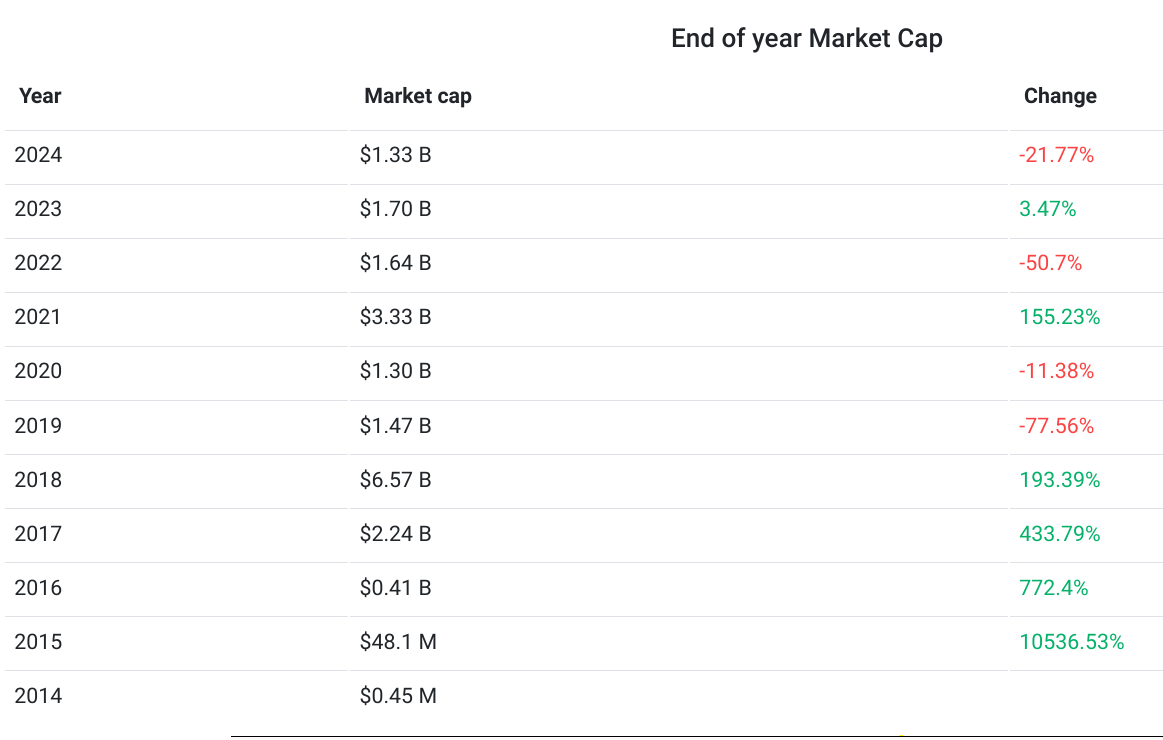
Source: companiesmarketcap.com
2019: Tilray faced a significant downturn, with its market cap plummeting to $1.47 billion, marking a sharp decline of 77.56%. Regulatory challenges, supply chain issues, and concerns over profitability contributed to the reversal in investor sentiment.
2020: Tilray's market cap remained relatively stable at $1.30 billion, reflecting a modest decline of 11.38% compared to the previous year. The company grappled with ongoing challenges in the cannabis market, including regulatory hurdles and pricing pressures.
2021: Tilray's market cap rebounded to $3.33 billion, driven by renewed optimism surrounding potential legalization developments and strategic partnerships. The company capitalized on growing acceptance of cannabis for both medicinal and recreational use.
2022: Tilray's market cap decreased to $1.64 billion, reflecting a decline of 50.7% compared to the previous year. The company faced continued challenges in scaling operations and achieving profitability amidst regulatory uncertainties and market competition.
2023: Tilray's market cap saw a slight recovery, reaching $1.70 billion, representing a 3.47% increase. The company likely focused on strategic initiatives to address operational inefficiencies and capitalize on emerging market opportunities.
2024: Tilray's market cap further declined to $1.33 billion, reflecting a 21.31% decrease from the previous year. The company continued to navigate industry headwinds, including regulatory hurdles, pricing pressures, and evolving consumer preferences.
B. Tilray Stock Price Return and Total Return
Tilray, a prominent cannabis company listed on the NASDAQ exchange under the ticker symbol TLRY, has exhibited varied performance metrics relative to the S&P 500 index over distinct timeframes. In the short term, Tilray's stock performance has shown signs of weakness. Over the past week, Tilray experienced a price return of -5.49%, slightly underperforming the S&P 500, which posted a return of -2.20%. This trend persisted over the one-month timeframe, with Tilray recording a price return of -10.42%, compared to the S&P 500's -3.24%. Such short-term underperformance suggests that Tilray investors may have incurred greater losses compared to those invested in the broader market.

Source: seekingalpha.com
Zooming out to the year-to-date performance, Tilray stock continues to lag behind the S&P 500. Year-to-date, Tilray's price return stands at -25.22%, significantly worse than the S&P 500's return of 5.05%. This indicates a prolonged period of underperformance by Tilray relative to the broader market index, suggesting potential challenges or weaknesses within the company or the cannabis industry as a whole.
The underperformance of Tilray stock becomes even more apparent when examining its performance over a one-year period. Tilray recorded a price return of -28.63% over the past year, while the S&P 500 posted a return of 20.61% during the same period. This substantial difference of -48% highlights Tilray's constant struggle to keep pace with the broader market index over the long term.
Over the past five years, Tilray's stock performance has demonstrated substantial declines compared to the S&P 500 index. Tilray's price return over this timeframe stands at -97%, reflecting a significant downward trend in the company's stock value. In contrast, the S&P 500 index posted a price return of 73% over the same period, showcasing the stark difference in performance between Tilray and the broader market. When considering total return, which includes dividends and other distributions reinvested, Tilray's performance over the past five years continues to lag significantly behind the S&P 500.
VI. Conclusion
Tilray Brands has seen significant fluctuations in its stock price, reflecting the dynamic nature of the cannabis industry and various influencing factors. While recent performance indicates challenges and struggles, projections and forecasts suggest potential opportunities for investors, albeit with varying degrees of optimism.
Short-term momentum for Tilray appears downward, with recent price declines indicating immediate challenges. However, expert insights and forecasts offer a cautiously optimistic outlook, projecting potential price targets of $4.25 by 2024, $5.75 by 2025, and even $15.65 or beyond by 2030 if global legalization trends accelerate. These projections are based on factors such as regulatory shifts, market dominance, international expansion, acquisitions, innovation, and financial performance.
Regarding trading cannabis stock Tilray (TLRY) through Contract for Difference (CFD) with VSTAR, several benefits may attract investors. VSTAR offers a Deposit Bonus, Copy Trading feature, Market Monitor feature, and educational resources. These features can enhance trading experience, mitigate risks, and provide valuable insights for making informed investment decisions.
FAQs
1. What was the highest price for Tilray stock?
The all-time high for Tilray stock was $214.06 on September 19, 2018.
2. Is TLRY a good buy?
Analyst consensus is mixed, with some suggesting a hold rating due to various challenges in the cannabis industry.
3. Is Tilray stock expected to go up?
Some analysts predict that Tilray stock could potentially rise more than 114% to over $3.43 within a year.
4. What is the 12-month price target for TLRY?
The average 12-month price target for Tilray is $2.71, with a high estimate of $4.00 and a low estimate of $2.00.
5. What is the price prediction for TLRY in 2025?
Predictions suggest a conservative estimate of $2.09 for TLRY stock.
6. What is the fair value of Tilray stock?
The fair value of Tilray stock is estimated to be around $3.58, which is above the current trading price.
7. Who owns the most shares of Tilray?
Brendan Kennedy is the largest individual shareholder, owning approximately 9.03 million shares, which is about 1.17% of the company.




